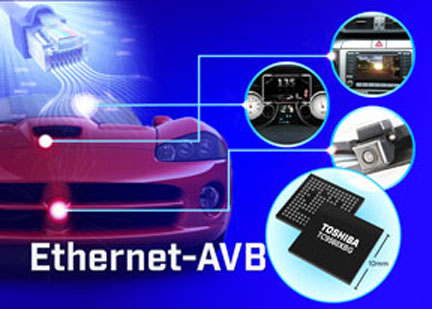As automotive technology evolves to provide increased features and services, market demands necessitate a more robust and higher-performing networking architecture. Existing automotive connectivity solutions were developed before the advent of in-car HD resolution screens, automotive cameras, advanced safety systems, and sophisticated infotainment. As these products and services become available to mainstream models, an easy–to-use and cost-effective in-car connectivity solution is needed.
Ethernet technology is well-suited for this application, as it can meet these needs and allow for broad deployment across all automotive market segments. It is by far the most widely deployed networking method, and the technology and IP are available from numerous manufacturers. Engineers are very familiar with Ethernet, and a realistic technology roadmap is readily available. Moreover, the standards, including IEEE’s Audio Video Bridging over Ethernet (AVB), are truly open, with lower development risks and costs.
Past solutions have been proprietary and/or high-cost, mismatched with the use models, or simply lacked market support for broad adoption. However, if we consider the market needs, Ethernet is an obvious choice for automotive connectivity. It is important to highlight some key features of the standards and how a developer can perhaps begin development.

Fig 1: Automotive technology is evolving quickly to provide more features.
Use cases
Traditionally, automotive Ethernet was available in limited-use cases, often for diagnostics and servicing. With the growth in requirements, engineers want to leverage what automotive Ethernet can offer. New automotive infotainment have HD displays, and perhaps multiple displays for a variety of video content. Automotive cameras may capture both external and in-car views. Using telematics modules, the car data can be accessed remotely, offering new application and business models. Some in-car use cases may involve streaming different HD content to the front- and back-seat displays, with common Internet streaming services enabling access to online content. It may also involve remote access to start the car, enable on-vehicle camera views, and set up user personality profiles (i.e., seat and mirror positions).
Ease of development
Many of the required development components are already available, using common development tools and environments. No proprietary, expensive, or unproven tools are needed for much of the development, which can take place using the engineer’s own PC and industry-standard tools. Once the bulk of development and testing is complete, the solution can simply be ported to the target.
Virtually any network engineer can begin development with very little new investment in tools or hardware. This not only reduces overall fixed development costs, but can greatly facilitate managing the development timeline and risk. Tools and services are widely available to ensure standards compliance, as are professional service providers with broad knowledge of the underlying technology.
Ethernet-AVB
The set of Ethernet standards commonly referred as Ethernet AVB (audio video bridging) allows for reliable delivery of data. In short, it is a quality of service (QoS) solution that provides seamless audio/video delivery throughout the network. AVB works by reserving a fraction of the available Ethernet bandwidth for AVB traffic. AVB packets are sent regularly in the allocated slots. As the bandwidth is reserved, there will be no collisions.
All of the nodes in the system share a clock. AVB packets have a presentation time that defines when the media packet should be played out. Using allocated bandwidth enables AVB to send data from endpoint to endpoint within a 2-ms window.
Many companies are supporting the growing requirement for automotive Ethernet and AVB. For example, Toshiba recently released the TC9560XBG Ethernet bridge device, making it easier for automotive OEMs to integrate the technology. It supports Ethernet-AVB and is AEC-Q100 Grade 3 compliant. When connected to an application processor or SoC host, the chip allows the delivery of audio, video, and data information through the 10/100/1000 Ethernet network. Samples are available now, and the device will go into mass production in October 2016.
Future needs
While networking environments may differ between the computing and automotive markets, organizations and standards have been extended to meet their unique needs, and there’s an established ecosystem. The technology is robust to meet future connectivity needs, from infotainment and telematics to safety, vehicle controls, security, and automated driving solutions.
Advertisement
Learn more about Toshiba America Electronic Components





